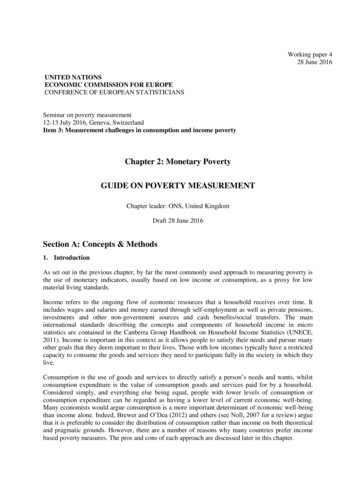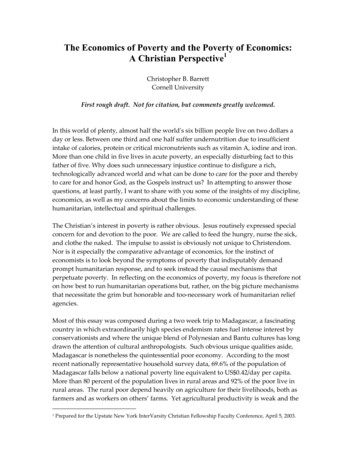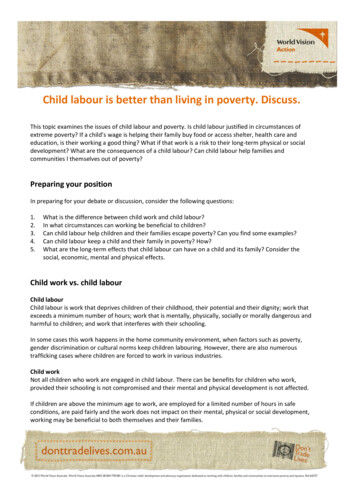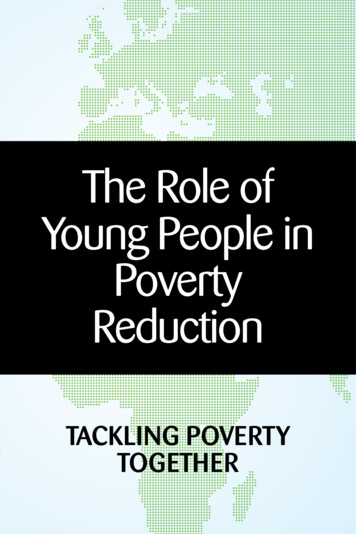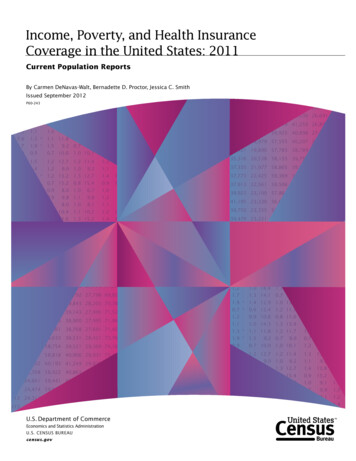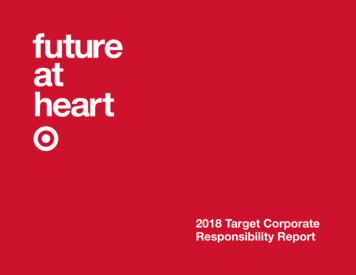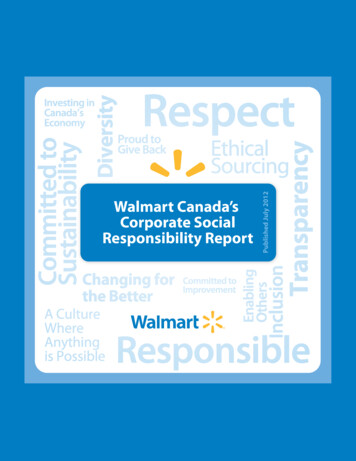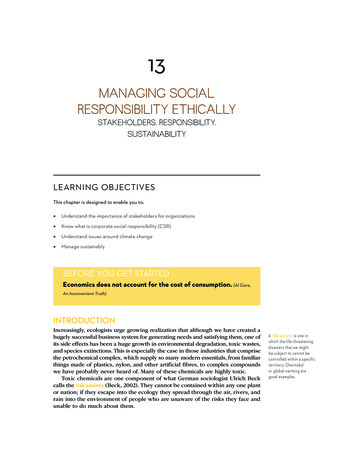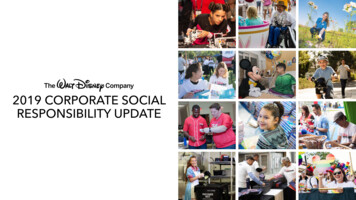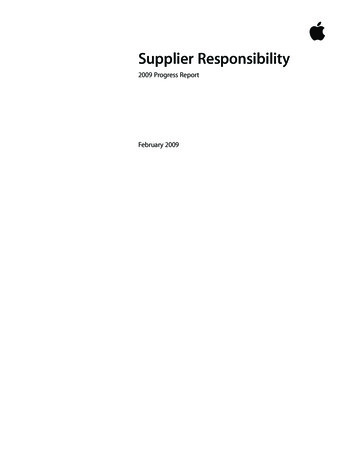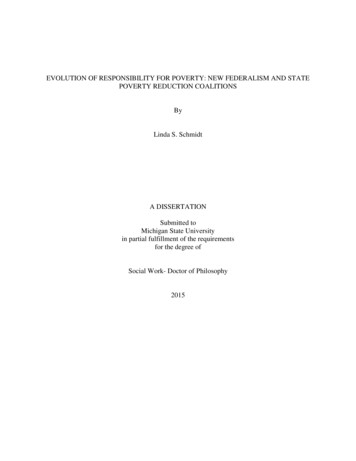
Transcription
EVOLUTION OF RESPONSIBILITY FOR POVERTY: NEW FEDERALISM AND STATEPOVERTY REDUCTION COALITIONSByLinda S. SchmidtA DISSERTATIONSubmitted toMichigan State Universityin partial fulfillment of the requirementsfor the degree ofSocial Work- Doctor of Philosophy2015
ABSTRACTEVOLUTION OF RESPONSIBILITY FOR POVERTY: NEW FEDERALISM AND STATEPOVERTY REDUCTION COALITIONSByLinda S. SchmidtThis research introduces a new model for understanding how narratives around povertyand federalism interact. This PovFed model uses a principal-agent structure to identify thefederalism orientation of individual states and a deservingness model to identify orientationtoward poverty. Putting these two together provides a tool for understanding how these twonarrative frameworks interact. The PovFed model enables social workers in policy and publicadministration conserve advocacy resources in the short term by framing policy options in linewith prevailing narratives, and provides a structure for building toward long-term narrativechange.The way we talk about policy issues conveys important evidence of the stories we formaround social problems. These shared stories are more deeply held than political or ideologicalorientations. Narrative policy analysis provides a framework for identifying linkages betweenthese explanatory stories and policy initiatives; creating a powerful tool for social workers andpublic administrators to increase the productivity of their efforts toward social justice goals. Thispaper tests the utility of this approach focusing on state poverty reduction initiatives and theintersectionality of causal stories related to poverty and the state-federal partnership.The debate over whether and how to intervene to reduce poverty and/or alleviate can bedescribed not as one coherent narrative but as several narrative frames that each remain relevant
today. Similarly, narrative frames regarding the parameters that bound state-level and federallevel intervention in poverty, the boundaries of federalism, remain both contested and enduring.Analyzing state poverty initiatives in the wake of the economic crisis of 2008-2009 reveals thatstates who took up these initiatives generally aligned with theories related to devolution ratherthan hollow state theories, as these states assign significant levels of agency to their level ofgovernment. These states also were aligned more strongly with causal stories or narrative themesrelated to poverty that locate cause in societal and economic spheres rather than on individualbehaviors. A typology of states is proposed that may future efforts to reduce poverty withinstates by focusing on causal stories. While further research is required to validate this typologywith larger sets of states and comparative data using a poverty measure that accounts for stateactions, this theoretical typology of states may inform future state-federal partnerships thatleverage the complexity of poverty-related narratives to reduce poverty.
Copyright byLINDA S. SCHMIDT2015
This work is dedicated to Christina Schmidt, who, upon being told girls don’t need high school,packed a bag and walked to town to get a job so she could finish school.v
ACKNOWLEDGEMENTSI sincerely appreciate the continued support of my committee members: Dr. MaryaSosulski, Dr. Gary Anderson, Dr. Rena Harold and Dr. Sarah Reckhow. I will repay yourpatience and support by ensuring my future students receive the same, especially when they havedoubts. I also want to thank Sanford Schram, Jodi Levin-Epstein, Susan Golonka and MarkGreenberg for their advice and guidance at critical times.Weathering varying political climates to maintain a focus on poverty is the work of manywhose perseverance and good humor have inspired me. First, I want to acknowledge the work ofpeople in poverty who are fighting against stigma and myth and leading the way for the rest ofus, such as the Poverty Fellows in Kalamazoo, MI, the members of Progress Village in TraverseCity, MI, and the leaders of Youth Voice in Detroit, MI. We could all learn so much more fromyou. Next, my many colleagues in state government around the country who largely remainanonymous but nonetheless carve a path for poverty to stay on the public policy agenda. Finally,I want to thank Dr. Donna Beagle, whose tireless work inspires me every day and whoseinsightful advice and unquenchable thirst for justice is without equal.I want to thank my First Friday group of rabble-rousers who do good work in ourcommunity and around the globe and who benevolently regard me as a sister on the journey.Last but never least, I appreciate my life partner and best friend Joe Sedlock who alsohappens to be the best public administrator and social worker I have ever met.vi
TABLE OF CONTENTSLIST OF TABLES. xLIST OF FIGURES . xiCHAPTER ONE: PROBLEM & THEORY. 1Problem Statement . 1Evolution of Quantitative Models & Lack of Connection to Narrative . 1Issues in the Use of Evidence . 4Need for Narrative to Understand Policy Context . 5A New Model for Policy Practice: the “PovFed” Narrative Model . 7Research Questions/ Theses. 7Overview of Chapters . 9CHAPTER TWO: HISTORY OF FEDERALISM IN RELATION TO POVERTY USING ANARRATIVE ANALYSIS APPROACH . 11Introduction . 11Absence of the Voice of People in Poverty . 12How Narratives are created: Relationship to politics and religion. 14Narrative Frames Regarding Government Role in Poverty . 15United States in Global Context . 19Narrative Frames Regarding Shared State-Federal Sovereignty/ Federalism . 24Historical Overview of Interactions between Federalism Related to Poverty . 301789-Civil War . 30Progressive Era. 35The Great Depression & the New Deal . 38Post WWII: Civil Rights and Great Society . 42New Federalism and Welfare Reform. 47Conclusion . 54CHAPTER THREE: METHODS. 56Methodological Orientation . 56Operationalizing Key Concepts . 57Agency as an indicator of federalism orientation. 57Deservingness as an indicator of poverty orientation . 59Narrative Policy Analysis . 60Sample Selection . 63Secondary Data Sources . 65Methods. 65vii
Comparative analysis using secondary data sources . 65Content Analysis and Thematic Coding . 66Applying the PovFed model . 67CHAPTER FOUR: ANALYSIS OF STATE POVERTY INITIATIVES. 69State Poverty Initiatives . 69Description of States . 71Shared Contextual Factors . 71National changes in poverty & Impact of Great Recession. . 72Poverty Measures Used by States. . 73Target setting and results-based accountability. . 73Basis of authority . 76Purpose(s) of State Initiatives. 77Collaborative policymaking. . 78Participation in State Initiatives. 79Interactions of poverty and federalism narratives . 80Recommendations as evidence of narrative . 80Thematic coding of recommendations . 81Narratives Related to Poverty . 82Causes of Poverty Identified by State Initiatives . 82Narratives related to deservingness: Recommendations by target group . 88Children and families . 88Sex . 89Race . 89Age/ older adults. 90Geography . 90Businesses. 90Narratives Related to Federalism . 91Specific federal programs and policies . 91Narratives related to devolution: Policies targeted by state recommendations . 93Narrative related to agency: Recommendations by type of action. . 95Increase access to existing programs . 95Expand program eligibility. 95Improve administration of programs . 96Reform tax structure . 96Create a new program or policy .
factors examined, and stresses the importance of avoiding “partialization” of factors in a search for significance; citing the already emergent practice of substituting statistical tests for
